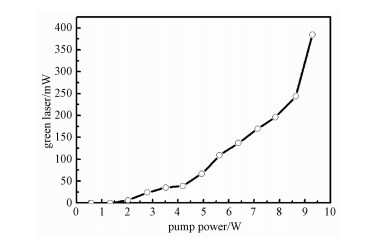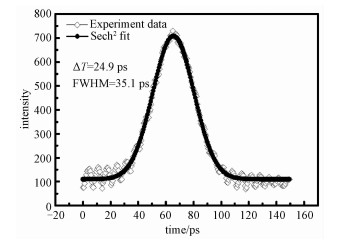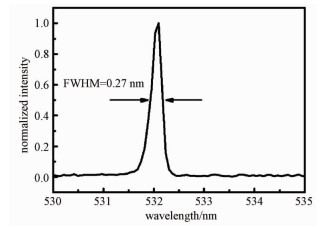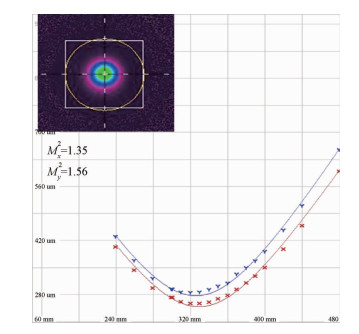

中国科学院半导体研究所全固态光源实验室,北京 100083;中国科学院大学材料科学与光电技术学院,北京 101407;北京市全固态激光先进制造工程技术研究中心,北京 100083
摘要: 介绍腔内倍频锁模的Nd:LuVO4-LBO绿光激光器,用SESAM作为可饱和吸收体,获得76 MHz、17.6 ps、385 mW的绿光输出,从泵浦光到绿光的光光转化效率为4.1%。实验中观察到绿光对SESAM锁模扰动的现象,分析其原因并成功地解决了该问题。
关键词: 腔内倍频Nd:LuVO4锁模绿光激光器
Ultrashort picosecond pulses are widely used in many areas, such as medicine, material processing, and scientific research[1-2]. In particular, the ultrafast picosecond green lasers with high repetition rate have been substantially investigated[3]. Such pulses can be generated by frequency doubling of mode-locked picosecond lasers. Recently, a great deal of efforts have concentrated on the Q-switched mode-locked or continuous-wave (CW) mode-locked intracavity frequency-doubled green laser with saturable absorber[4-7]. Pang et al.[8-9]reported a semiconductor saturable absorber mirror (SESAM) passive mode-locked Nd:YVO4 intracavity frequency-doubled laser with a potassium titanyl phosphate crystal (KTP) and a lithium triborate crystal (LBO). They obtained 90 mW picosecond green output with a pulse duration of 29.7 ps by KTP and 140 mW with 3.67 ps by LBO. Later, Cai et al.[10] investigated a passively CW mode-locked green laser using Nd:YVO4 with KTP. They selected reflective single-walled carbon nanotubes to achieve mode-locking and produced 456 mW output power with a pulse width of 7.1 ps. Recently, Li et al.[11] demonstrated a CW Kerr-lens mode-locked Nd:YVO4 laser and frequency doubled with KTP. The repetition rate was 1.1 GHz and the output power of the green laser was 258 mW. Due to the weak thermal conduction of Nd:YVO4 crystal, researchers[12] demonstrated a passively mode-locked laser using a YVO4/Nd:YVO4 composite crystal with KTP as the frequency-doubling crystal and obtained a maximum output power of 2.06 W of the green laser with a pulse width of 18 ps. Li et al.[13] reported a SESAM mode-locked Nd:GdVO4 laser (frequency doubled with KTP) and they achieved 396 mW output at 532 nm and a pulse duration of 5.5 ps. As seen in the above-mentional references, research interests have focused on Nd:GdVO4 and Nd:YVO4 lasers with KTP and LBO as the nonlinear media for frequency doubling. It is well-known that Nd:LuVO4 is a vanadate crystal with many excellent properties[14]. Its emission and absorption cross sections are 14.6×10-19 cm2 at 1 064 nm and 6.9×10-19 cm2 at 808 nm, respectively, which are higher than those of Nd:YVO4 and Nd:GdVO4[15-16]. In addition, its thermal conductivity is better than that of Nd:YVO4. Therefore, a mode-locked Nd:LuVO4 laser is also a suitable candidate for intracavity frequency doubling.
In this manuscript, we describe an intracavity frequency-doubled green laser at 532 nm using a SESAM mode-locked Nd:LuVO4 laser at 1 064 nm with LBO. Experimentally, we chose the LBO crystal for second-harmonic generation due to its large angular and temperature acceptances and high damage threshold[17]. The maximum output power was 385 mW when the pump power was 9.3 W. The corresponding repetition rate was 76 MHz and the pulse width was 17.6 ps.
1 Experimental setupThe experimental apparatus was shown in Fig. 1. A simple folding cavity was used. The pumping laser was a fiber-coupled diode laser (DILAS:M1F1S22-808.3-35C-T25-SS2. 13-2 m SMA). It was cooled at a temperature of 18 ℃ with circulating water and its emission wavelength was 808 nm. The pigtailed fiber had a numerical aperture (NA) of 0.22 and a core diameter of 105 μm. The pump light was coupled with a beam expanding system (expansion ratio 1:3) and focused on the Nd:LuVO4 crystal. The laser crystal was planar cut with its optical axis parallel to the propagation direction. Its dimensions were 3 mm×3 mm×6 mm with 0.5 at.% doping of Nd. A water-cooled copper holder was selected for cooling the crystal, which was wrapped with indium foil. The pump side of the laser crystal was antireflection (AR) coated both at 1 064 nm and 808 nm while the other side was AR coated at 1 064 nm to reduce Fresnel loss in the cavity. The LBO crystal, whose dimensions were 3 mm×3 mm×20 mm, was cut for type-Ⅰ phase matching with θ=90°, φ=0°. Its operation temperature was set at T=152 ℃. Both ends of the LBO were AR coated at 532 nm and 1 064 nm to reduce loss. The SESAM soldered on a small copper block was a commercial product of BATOP. Its central wavelength was at 1 064 nm and the saturation fluence was 90 μJ/cm2.
Fig. 1
 | Download: JPG larger image |
Fig. 1 Experimental setup of intracavity frequency-doubled passive mode-locked Nd:LuVO4-LBO green laser | |
The input mirror M1 was high reflection (HR) coated at 1 064 nm and AR coated at 808 nm. The flat mirror M2 was HR coated at 1 064 nm. The concave mirror M3 with curvature radius of 1 000 mm was HR coated at 1 064 nm. M4 was AR coated at 532 nm and HR at 1 064 nm, to allow the transmittance of the green laser. The focusing lens M5, with a focal length of 150 mm, was AR coated both at 1 064 nm and 532 nm. M6 was AR coated at 1 064 nm and HR at 532 nm. The total length of the cavity was approximately 1.95 m.
2 Experimental results and discussionsFirst, to observe the laser operation, we replaced M2 with an output coupler (OC) with 3% transmission and tried to obtain mode locking at the fundamental wavelength. We successfully realized a CW passive mode-locked laser when the pump power was 2.79 W or higher. As the pump power increased, the output power increased linearly. The maximum output power reached 1.6 W when the pump power was 9.3 W. The optical-to-optical conversion efficiency from the pump to the output at 1 064 nm was 17.2%.
Then, we inserted the LBO in the cavity, and carefully adjusted the alignment. Finally, we replaced 3% OC with the M2. Heating the LBO crystal to achieve noncritical phase matching, and eventually we obtained the frequency doubled green laser. The average output power of the green laser as a function of the pump power was shown in Fig. 2. When the pump power reached 9.3 W, the maximum output power of the frequency-doubled green laser was 385 mW and the optical conversion efficiency was 4.1% from the pump light to the green laser.
Fig. 2
 | Download: JPG larger image |
Fig. 2 Output power of green laser versus pump power | |
In our experiment, we found that the threshold for achieving the continuous wave mode-locked green laser occurred at a pump power of 4.19 W. Obviously, inserting the LBO into the cavity increased the threshold of the mode locking. The main reasons were as follows. First, the spot size on the SESAM became larger after inserting the LBO and, as a result, the laser energy density on the SESAM was reduced. Second, introducing the LBO into the cavity increased the cavity loss due to the residual Fresnel losses on the crystal's surfaces, while the process of frequency doubling would consume part of the fundamental beam and thus increased the loss in the laser cavity.
The pulse trains of the green laser measured in different time scales (100 ns/div and 10 ns/div) using a fast oscilloscope (Agilent DSO6 104 A) was shown in Fig. 3. The repetition rate was 76 MHz. The pulse width of the picosecond green laser could not be directly measured by the autocorrelator due to the lack of the frequency doubling crystal for 532 nm. Therefore, by measuring the pulse width of the fundamental laser, we could calculate the pulse width of the green laser based on the formula:
Fig. 3
 | Download: JPG larger image |
Fig. 3 Pulse trains of the green laser in time scales of 100 ns/div (a) and 10 ns/div (b), respectively | |
The autocorrelation trace of the mode locked Nd:LuVO4 laser pulses measured by an autocorrelator (SM-1200, APE Inc.) was shown in Fig. 4. It was found that the pulse duration was 24.9 ps for the fundamental output by assuming a sech2 pulse shape. So the pulse width of the green laser was calculated to be approximately 17.6 ps.
Fig. 4
 | Download: JPG larger image |
Fig. 4 Autocorrelation trace (hollow diamond) of mode-locked Nd:LuVO4 laser pulses and sech2 fitting (filled circle) | |
Figure 5 gave the spectrum of the picosecond green laser, as detected by a spectrometer (AvaSpec-ULS3648-4-USB2 with a resolution of 0.14 nm). Its full width at half maximum (FWHM) was 0.27 nm before deconvolution.
Fig. 5
 | Download: JPG larger image |
Fig. 5 Spectrum of the picosecond green laser | |
The beam quality of the picosecond green laser, measured by a beam propagation analyzer (M2-200S-FW), was shown in Fig. 6. The M2 factor was Mx2=1.35 and My2=1.56, respectively.
Fig. 6
 | Download: JPG larger image |
Fig. 6 Beam quality parameter M2 measurement for the mode-locked green laser (the upper inset: 2D near-field energy fluence profile) | |
At the beginning, M6, which was HR coated at 532 nm and AR coated at 1 064 nm, was not used in the resonator when the laser was operated in mode-locking at 1 064 nm. However, it was interesting to note that when we adjusted the temperature of the LBO to optimize the output power of the green laser, we found that the generated green laser was a continuous wave and no mode-locking was seen. At this point, we replaced M2 with the 3% OC and found that the fundamental frequency light was also a continuous wave. When the LBO temperature dropped to room temperature and no frequency-doubling was generated, the mode locking of the fundamental laser immediately resumed. Apparently, it was the generated green laser that interrupted the mode locking. To maintain stable mode-locking, one needs to block the interference of the green light. A dichroic mirror M6, which allowed the laser to pass through at 1 064 nm and be blocked at 532 nm, was introduced to the resonator to prevent the green light from shining on the SESAM and to maintain both mode locking of fundamental laser and generation of the green laser.
It is clear that the process of saturable absorption is affected by the generated green laser. As we all know that semiconductor absorbers have an intrinsic bitemporal impulse response. The slower response, interband trapping and recombination processes, plays a vitally important part in starting the pulse formation process and for pulse forming in picosecond pulsed lasers[19-20]. The process of saturable absorption can be summarized as follows: at high optical intensities, the initial states are depleted so that the absorption is reduced and an optical pulse is formed[21]. When the green laser hits the saturable absorber, both the fundamental laser and the green laser will be more or less absorbed simultaneously. The photon energy of the green laser is greater than the band-gap energy of the saturable absorber, which has less energy than that of the fundamental frequency of the laser[22]. So we believe that the green laser generated in the CW mode destroyed the saturable absorption of the SESAM. The process of periodic loss modulation in the absorbers is disturbed and the mode locking is interrupted[21-23]. Therefore, it is necessary to insert M6 into the cavity to avoid the green light interfering with the SESAM and to maintain both the mode locking of the fundamental laser and the frequency-doubled green laser. This is a useful lesson for constructing an intracavity frequency-doubled laser using SESAM as the mode-locker.
3 ConclusionIn summary, we presented a picosecond green laser generated by intracavity frequency doubling of a passively mode-locked Nd:LuVO4 laser using a type-Ⅰ phase-matched and temperature tuned LBO. The maximum average output power of the green laser was 385 mW with a pulse width of 17.6 ps and a repetition rate of 76 MHz. The optical conversion efficiency from the pumping diode laser to the green laser was 4.1%. The beam quality was excellent with an M2-factor of Mx2=1.35 and My2=1.56. We also observed the interference of the frequency-doubled green light with the normal operation of SESAM, analyzed the reason and eventually resolved the problem. The experimental results show that Nd:LuVO4 crystal is an excellent candidate for a picosecond green laser.
References
| [1] | Young M D, Backus S, Durfee C, et al. Multiphoton imaging with a direct-diode pumped femtosecond Ti:sapphire laser[J].Journal of Microscopy, 2013, 249(2):83–86.DOI:10.1111/j.1365-2818.2012.03688.x |
| [2] | Novak O, Turcicova H, Smrz M, et al. Picosecond green and deep ultraviolet pulses generated by a high-power 100kHz thin-disk laser[J].Optics Letters, 2016, 41(22):5210–5213.DOI:10.1364/OL.41.005210 |
| [3] | Peng R W, Guo L, Zhang X F, et al. 43W picosecond laser and second-harmonic generation experiment[J].Optics Communications, 2009, 282(4):611–613.DOI:10.1016/j.optcom.2008.10.049 |
| [4] | Li S, Li D, Zhao S, et al. 11MW peak power in doubly QML composite Nd:YVO4/Nd:YVO4/Nd:YVO4/KTP sub-nanosecond green laser with EO and Bi-GaAs[J].Optics Express, 2016, 24(4):4022–4028.DOI:10.1364/OE.24.004022 |
| [5] | Kovalev A V, Polyakov V M, Mak A A, et al. Mode-locking in intracavity frequency doubled Nd: YVO4 Laser[C]//Clarkson W A, Shori R K. Solid State Lasers XXIV: Technology and Devices, Bellingham: Spie-Int Soc Optical Engineering, 2015: 93421M. |
| [6] | Tang W, Zhao S, Yang K, et al. Numerical simulation of subnanosecond single mode locking pulse generation in a doubly Q-switched and mode-locked green laser with EO and Cr4+:YAG[J].Journal of the Optical Society of America B, 2015, 33(1):1–7. |
| [7] | Wang W, Liu J, Chen F, et al. 532 nm picosecond pulse generated in a passively mode-locked Nd:YVO4 laser[J].Chinese Optics Letters, 2009, 7(8):706–708.DOI:10.3788/COL |
| [8] | Pang Q S, Fu J, Chang L, et al. Laser diode end pumped intracavity frequency doubling semiconductor saturable absorber mirror passively mode-locked picosecond lasers[J].Optics Communications, 2011, 284(20):4983–4985.DOI:10.1016/j.optcom.2011.06.065 |
| [9] | Pang Q S, Chen M, Liu Z X, et al. LD end-pumped intracavity frequency doubling SESAM passively mode-locked picosecond lasers[J].Laser Physics, 2011, 21(6):1031–1034.DOI:10.1134/S1054660X11110211 |
| [10] | Cai W, Peng Q, Hou W, et al. Picosecond passively mode-locked laser of 532nm by reflective carbon nanotube[J].Optics & Laser Technology, 2014, 58:194–196. |
| [11] | Li Z H, Peng J Y, Yuan R X, et al. Compact and high repetition rate Kerr-lens mode-locked 532nm Nd:YVO4 laser[J].Laser Physics, 2015, 25(11):115001.DOI:10.1088/1054-660X/25/11/115001 |
| [12] | Li T, Zhao S Z, Zhuo Z, et al. Passively mode-locked YVO4/Nd:YVO4composite crystal green laser with a semiconductor saturable absorber mirror[J].Laser Physics Letters, 2009, 6(1):30–33.DOI:10.1002/lapl.v6:1 |
| [13] | Li L, Liu J, Liu M, et al. 532nm continuous wave mode-locked Nd:GdVO4 laser with SESAM[J].Laser Physics Letters, 2009, 6(2):113–116.DOI:10.1002/lapl.v6:2 |
| [14] | Liu B, Li Y, Jiang H L. Nd:LuVO4 as a true three-level laser[J].Laser Physics Letters, 2011, 8(8):575–578.DOI:10.1002/lapl.v8.8 |
| [15] | Maunier C, Doualan J L, Moncorge R, et al. Growth, spectroscopic characterization, and laser performance of Nd:LuVO4 a new infrared laser material that is suitable for diode pumping[J].Journal of The Optical Society of America B-optical Physics, 2002, 19(8):1794–1800.DOI:10.1364/JOSAB.19.001794 |
| [16] | Zhao S R, Zhang H J, Liu J H, et al. Growth of excellent-quality Nd:LuVO4 single crystal and laser properties[J].Journal of Crystal Growth, 2005, 279(1/2):146–153. |
| [17] | Nikogosyan D N. Lithium triborate (LBO):a review of its properties and applications[J].Applied Physics A, 1994, 58(3):181–190.DOI:10.1007/BF00324374 |
| [18] | Mukhopadhyay P K, Alsous M B, Ranganathan K, et al. Analysis of laser-diode end-pumped intracavity frequency-doubled, passively Q-switched and mode-locked Nd:YVO4 laser[J].Applied Physics B, 2004, 79(6):713–720.DOI:10.1007/s00340-004-1626-z |
| [19] | Keller U, Weingarten K J, Kartner F X, et al. Semiconductor saturable absorber mirrors (SESAM's) for femtosecond to nanosecond pulse generation in solid-state lasers[J].IEEE Journal of Selected Topics in Quantum Electronics, 1996, 2(3):435–453.DOI:10.1109/2944.571743 |
| [20] | Keller U. Recent developments in compact ultrafast lasers[J].Nature, 2003, 424(6950):831–838.DOI:10.1038/nature01938 |
| [21] | Paschotta R. Encyclopedia of laser physics and technology[M].Weinheim: Wiley-VCH, 2008: 416-418. |
| [22] | Takahashi K, Hayakawa T, Suyama T, et al. energy-band structure of (AlAs) (GaAs) superlattices[J].Journal of Applied Physics, 1988, 63(5):1729–1732.DOI:10.1063/1.339909 |
| [23] | Linsheng L, Su L, Wenxin W, et al. Study of electron spin relaxation time in GaAs (110) quantum wells[J].Journal of Semiconductors, 2007, 28(6):856–859. |
